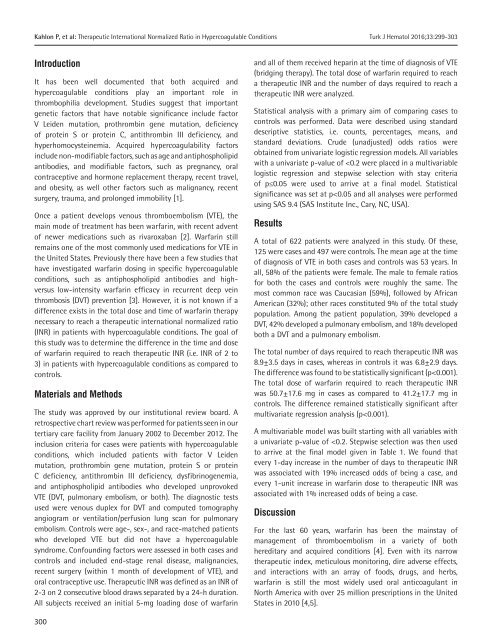Turkish Journal of Hematology Volume: 33 - Issue: 4
You also want an ePaper? Increase the reach of your titles
YUMPU automatically turns print PDFs into web optimized ePapers that Google loves.
Kahlon P, et al: Therapeutic International Normalized Ratio in Hypercoagulable Conditions<br />
Turk J Hematol 2016;<strong>33</strong>:299-303<br />
Introduction<br />
It has been well documented that both acquired and<br />
hypercoagulable conditions play an important role in<br />
thrombophilia development. Studies suggest that important<br />
genetic factors that have notable significance include factor<br />
V Leiden mutation, prothrombin gene mutation, deficiency<br />
<strong>of</strong> protein S or protein C, antithrombin III deficiency, and<br />
hyperhomocysteinemia. Acquired hypercoagulability factors<br />
include non-modifiable factors, such as age and antiphospholipid<br />
antibodies, and modifiable factors, such as pregnancy, oral<br />
contraceptive and hormone replacement therapy, recent travel,<br />
and obesity, as well other factors such as malignancy, recent<br />
surgery, trauma, and prolonged immobility [1].<br />
Once a patient develops venous thromboembolism (VTE), the<br />
main mode <strong>of</strong> treatment has been warfarin, with recent advent<br />
<strong>of</strong> newer medications such as rivaroxaban [2]. Warfarin still<br />
remains one <strong>of</strong> the most commonly used medications for VTE in<br />
the United States. Previously there have been a few studies that<br />
have investigated warfarin dosing in specific hypercoagulable<br />
conditions, such as antiphospholipid antibodies and highversus<br />
low-intensity warfarin efficacy in recurrent deep vein<br />
thrombosis (DVT) prevention [3]. However, it is not known if a<br />
difference exists in the total dose and time <strong>of</strong> warfarin therapy<br />
necessary to reach a therapeutic international normalized ratio<br />
(INR) in patients with hypercoagulable conditions. The goal <strong>of</strong><br />
this study was to determine the difference in the time and dose<br />
<strong>of</strong> warfarin required to reach therapeutic INR (i.e. INR <strong>of</strong> 2 to<br />
3) in patients with hypercoagulable conditions as compared to<br />
controls.<br />
Materials and Methods<br />
The study was approved by our institutional review board. A<br />
retrospective chart review was performed for patients seen in our<br />
tertiary care facility from January 2002 to December 2012. The<br />
inclusion criteria for cases were patients with hypercoagulable<br />
conditions, which included patients with factor V Leiden<br />
mutation, prothrombin gene mutation, protein S or protein<br />
C deficiency, antithrombin III deficiency, dysfibrinogenemia,<br />
and antiphospholipid antibodies who developed unprovoked<br />
VTE (DVT, pulmonary embolism, or both). The diagnostic tests<br />
used were venous duplex for DVT and computed tomography<br />
angiogram or ventilation/perfusion lung scan for pulmonary<br />
embolism. Controls were age-, sex-, and race-matched patients<br />
who developed VTE but did not have a hypercoagulable<br />
syndrome. Confounding factors were assessed in both cases and<br />
controls and included end-stage renal disease, malignancies,<br />
recent surgery (within 1 month <strong>of</strong> development <strong>of</strong> VTE), and<br />
oral contraceptive use. Therapeutic INR was defined as an INR <strong>of</strong><br />
2-3 on 2 consecutive blood draws separated by a 24-h duration.<br />
All subjects received an initial 5-mg loading dose <strong>of</strong> warfarin<br />
and all <strong>of</strong> them received heparin at the time <strong>of</strong> diagnosis <strong>of</strong> VTE<br />
(bridging therapy). The total dose <strong>of</strong> warfarin required to reach<br />
a therapeutic INR and the number <strong>of</strong> days required to reach a<br />
therapeutic INR were analyzed.<br />
Statistical analysis with a primary aim <strong>of</strong> comparing cases to<br />
controls was performed. Data were described using standard<br />
descriptive statistics, i.e. counts, percentages, means, and<br />
standard deviations. Crude (unadjusted) odds ratios were<br />
obtained from univariate logistic regression models. All variables<br />
with a univariate p-value <strong>of</strong>

















